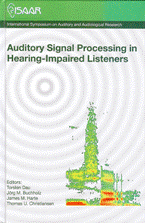Frequency transposition and the effect of training
Abstract
Linear Frequency Transposition (LFT) was introduced recently in a commercially available hearing aid. The Widex Inteo Audibility Extender shifts or transposes a high frequency sound linearly down one octave. This frequency shift can potentially increase speech intelligibility for hearing aid users with severe high frequency hearing losses. Preliminary experiments showed increased audibility of high frequency environmental sounds but little influence on speech understanding. One possible reason for this is that acclimatization or training is needed for this type of signal processing. In this study the effects of training on the identi cation of phonemes is investigated using nor- mal hearing subjects with simulated hearing loss above 1600 Hz. The subjects were tested using pre-recorded stimuli from the Inteo hearing aid both with LFT and normal amplification. The study was conducted over three sessions on separate dates. Each session included three tests separated by 15 minutes of training. The results show that training significantly increases the ability to use the transposed acoustic cues. It is shown that for both fricatives and stop consonants the identification scores with LFT improved relative to normal amplification. These results indicate that it may be important to use training to derive the optimal benefit from frequency transposition.
References
Kuk, F., Korhonen, P., Peeters, H., Keenan, D., Jessen, A., and Andersen, H. (2006). “Linear Frequency Transposition: Extending the Audibility of High-Frequency Information,” The Hearing Review, 13(10), 42-48.
Kuk, F., Keenan, D., Peeters, H., Korhonen, P., Hau, O., and Andersen, H. (2007a). “Critical Factors in Ensuring Efficacy of Frequency Transposition Part 1: Individualizing the start frequency,” The Hearing Review, 14(3), 60-67.
Kuk, F., Keenan, D., Peeters, H., Lau, C., and Crose, B. (2007b). “Critical Factors in Ensuring Efficacy of Frequency Transposition Part 2: Facilitating Initial Adjustment,” The Hearing Review, 14(4), 90-96.
Additional Files
Published
How to Cite
Issue
Section
License
Authors who publish with this journal agree to the following terms:
a. Authors retain copyright* and grant the journal right of first publication with the work simultaneously licensed under a Creative Commons Attribution License that allows others to share the work with an acknowledgement of the work's authorship and initial publication in this journal.
b. Authors are able to enter into separate, additional contractual arrangements for the non-exclusive distribution of the journal's published version of the work (e.g., post it to an institutional repository or publish it in a book), with an acknowledgement of its initial publication in this journal.
c. Authors are permitted and encouraged to post their work online (e.g., in institutional repositories or on their website) prior to and during the submission process, as it can lead to productive exchanges, as well as earlier and greater citation of published work (See The Effect of Open Access).
*From the 2017 issue onward. The Danavox Jubilee Foundation owns the copyright of all articles published in the 1969-2015 issues. However, authors are still allowed to share the work with an acknowledgement of the work's authorship and initial publication in this journal.


